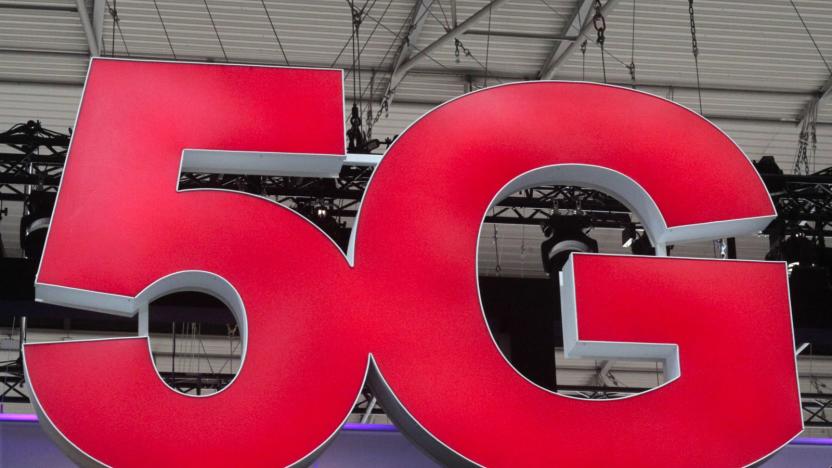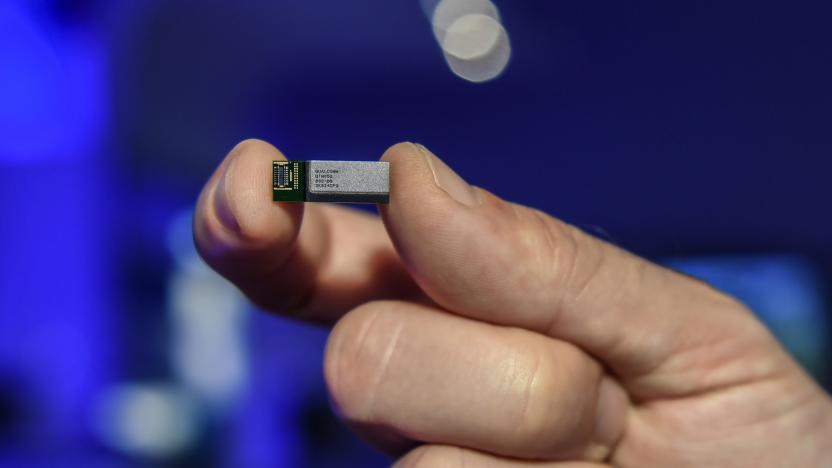MillimeterWave
Latest

Verizon's 5G Home internet and TV service launches October 1st
Today Verizon announced it's launching "the world's first commercial 5G broadband internet service" on October 1st. 5G Home service uses the next generation wireless technology to offer home internet service without a cable or fiber hookup. Residents of "certain neighborhoods" in Houston, Indianapolis, Los Angeles and Sacramento can pre-order access beginning on Thursday to get their service free for the first three months. Priced at $50 for people who already have Verizon wireless and $70 for those who don't, it's promising speeds of "around 300 Mbps" up to 1 Gbps, with no data caps. Beyond the "First On 5G" marketing push, Verizon is also branding its service as being built on a "5G Ultra Wideband Network" because of its spectrum holdings, fiber connections and small cell base stations. A video angle comes courtesy of Apple and Google. The package includes three months of free access to YouTube TV, plus a free Apple TV 4K or Chromecast Ultra. "White glove" installation is free, as well as a free router and "router upgrades" due next year, plus a promise that customers will get first dibs on 5G Mobile devices once those hit the market.

How 5G makes use of millimeter waves
It took a while, but the first ever 5G spec was finally approved late last year. 5G NR, as it's called, will bring about super fast mobile internet by tapping into new spectrum. We're expecting to see the first 5G-ready phones in the first half of 2019, although most people likely won't experience the full benefits of the new technology until about a year later. Still, 5G NR promises to dramatically improve cellular internet speeds and enable experiences like always connected laptops or livestreaming from VR headsets. The entire mobile industry is excited as hell for it, so here's a little guide to help you make sense of the hype.

Qualcomm's 5G antennas are primed for next year's phones
One of the biggest challenges in tapping millimeter waves (mmWaves) for 5G is overcoming signal interference. Because they're easily disrupted by something as simple as someone walking in between a transmitter and receiver, mmWaves require technological finesse to be harnessed reliably. To that end, Qualcomm today unveiled what it says is the world's "first fully-integrated 5G NR mmWave and sub-6 GHz RF modules for smartphones and other mobile devices." These are the QTM052 mmWave antenna module family and the QPM56xx sub-6 GHz radio frequency (RF) module, and they'll pair with the company's previously announced Snapdragon X50 5G modem -- making next-gen phone networks a reality very soon.

'Hovering' antennas promise speedy 5G phone networks
Wireless networks already have to deal with increasingly crowded waves, and that's only going to get worse when 5G rolls around. Any boost to the signal could lead to a big jump in performance, especially when you're using very high frequencies that are more prone to interference. But how do you provide that boost? Researchers have an idea: 'hover' the antenna. They've developed millimeter wave antenna arrays that are almost entirely separated from the substrate you'd usually mount them on, preventing that substrate from weakening the signal like it does with conventional antennas.

Columbia researchers might have the key to wireless VR
The millimeter wave frequency has the potential to do a lot. So far it's helping power 5G cell networks, but research from Columbia Engineering could expand that to self-driving cars and virtual reality headsets. It's a little dense, but the key bit is that the team figured out a new nonreciprocal way to transmit the waves, by using "carefully synchronized high-speed transistor switched that route forward and reverse waves differently." The school says it's basically like two trains charging head on on the same track, with them switching tracks at the last possible second.

Apple granted approval to test its 5G wireless technology
The FCC has approved an application for Apple to begin testing its 5G technology, which means the company is joining a number of others already working towards bringing 5G to the masses. Sprint is looking to launch its 5G service in 2019, while T-Mobile is shooting for 2020. AT&T and Verizon are making moves towards 5G networks as well.

Verizon outbids AT&T for key 5G wireless spectrum (updated)
A month ago, AT&T announced it would acquire Straight Path Communications for $1.6 billion, specifically because Straight Path owns licenses to use high-frequency radio waves that will be crucial for the next generation of wireless technology. However, after that agreement, an unnamed Multi-National Telecommunications Company (that is reportedly Verizon, the owner of this website) stepped up with a bid of $3.1 billion in stock, and tonight the Wall Street Journal reports that AT&T has declined to match it.

Google Fiber considers gigabit WiFi to cheaply cover last mile
Google Fiber has been the Holy Grail of local internet aficionados for its blisteringly fast speed and independence from established internet providers. But setting up all its infrastructure is a huge, expensive undertaking. So Google's parent company Alphabet is exploring a cheaper alternative to physically hooking up every home and business: gigabit WiFi.

Facebook might have a solution to its free WiFi's shortcomings
Facebook knows that a key limitation of its Terragraph gigabit WiFi system is how it falls apart over long distances. Line of sight is kind of a pain that way. So the company has devised a workaround for it with a code framework dubbed Open/R that helps nodes on the network make faster, autonomous decisions about data routing. The way the network operates is that data is transmitted incredibly quickly (by up to 7Gbps) and over short distances from one node to the next. But any obstructions in the visible path between nodes can cause the signal to degrade.

Verizon starts testing 5G wireless in the field
At last, 5G cellular data is leaving the lab. Verizon and Samsung have started testing the multi-gigabit wireless access in "real-world" conditions around Verizon's HQ, including indoors and in moving vehicles. The experience isn't the same as what you'd get on a phone -- this involves specialized equipment just a short hop away from a base station -- but the early results are promising. There's enough bandwidth to comfortably stream 4K video, including VR clips that require 17 simultaneous feeds. For all intents and purposes, you're getting fiber optic speeds over a long-range wireless link.

Facebook eyes millimeter-wave wireless to power free internet
Despite a major setback in India, Facebook is still working on expanding its Free Basics service (part of internet.org) for developing nations. The company told the Verge that it's researching wireless networks that use extremely high-frequency millimeter-wave bands. It applied for at least two patents on the tech, which is similar to that proposed by Starry, the company led by fomer Aereo CEO Chet Kanojia. "This work is part of the Connectivity Lab which supports the mission of Internet.org -- to connect the four billion people who don't have Internet access," a representative said.

China has a microwave pain weapon of its own
The US may never have used its microwave pain gun in combat, but that isn't stopping China from exploring the concept of non-lethal force. Local manufacturer Poly has unveiled the WB-1, a millimeter-wave weapon that heats the water under your skin (much like the US' Active Denial System) to deliver intense agony without injury. It currently works at a relatively short range of about 262 feet, but extra power can bump that up to 0.6 miles -- if you know where to shoot, you could cause misery from afar. It's reportedly meant to be used on the high seas, where it could enforce China's territorial claims without the need to capture or destroy wayward vessels.

Panasonic details radar-based technology that can detect collisions in low light
Collision detection for cars? Yeah, scientists are on that. But whenever we read about concepts like this, the accompanying literature is often curiously light on details pertaining to real-life driving conditions; it's often unclear how well the tech will fare if you dredge it up on a foggy day, or in the middle of torrential storm. But in that press release you see down there, low visibility and poorly lit roads are all Panasonic wants to talk about. The company just unveiled its new crash-avoidance system, which, like other concepts we've seen, uses millimeter-wave radar technology to detect pedestrians and bicyclists. Since humans tend to reflect weaker radar signals than cars, Panasonic has designed a new pulse radar code sequence that allows pedestrians to leave a bigger footprint. It's so effective, the company claims, that it can detect bystanders up to 40 meters (131 feet) away, and will work at night and through rain, fog, snow and blinding sunlight. That all sounds promising, of course, but as with other concepts, it's not clear, when, exactly we'll see this system put to good use in the real world.

DARPA planning high-speed wireless for soldiers in the field
DARPA has its hands and, more importantly, its money in just about everything. Weapons, robots, thermal sensors -- it's a staple of the scientific community. But, it's also a military agency with basic needs, like internet access. The research group's newest project doesn't carry heavy loads (unless you're weighing your cargo in kilobytes) and can't break the sound barrier, but it should be able to deliver 4G speeds to even the most remote of battlefields. DARPA has $11.8 million set aside for its Mobile Hotspots program which will use millimeter-wave signals to deliver high-speed data connections to dismounted soldiers, forward-operating bases and tactical centers. Most importantly, each node in the network extends its range building out a mesh that isn't reliant on existing infrastructure. For more details hit up the PR after the break.

Multi-gigabit wireless broadband within our grasp, capped data plans laugh in our face
Bring it on, LTE-Advanced. In case you've been looking for ways to eat up your capped data plan any faster, a researcher from Samsung proclaims that speeds up to 5.5gbps (yes, with a g) might be reachable within the next five years -- as long as all the stars align, that is. Jerry Pi demonstrated the idea, which involves the use of millimeter wave spectrum that lies between 3GHz and 300GHz. If -- and that's a big if -- the spectrum can be secured, the next hurdle will be the engineering challenge of deploying a wireless broadband network at such high frequencies; even tiny oxygen molecules, let alone walls and trees, would easily break up a signal at that range. Pi mentions that he and his fellow researchers are working on a few ideas to get around these obstacles, and outlines everything in significant detail in his 100+ slide presentation, which can be accessed below. Don't get us wrong: the idea of broadband data speeds hitting 5.5gbps makes us salivate, but it would definitely need to come with an unlimited plan. Just sayin'.

Toyota's new crash-avoidance technology takes control of the wheel
Crash-avoidance technology in cars is hardly anything new, of course, but Toyota's gone a bit further than most with its latest effort. While complete details are still a bit light (including any word of an actual rollout to vehicles), the new system is said to use a combination of both front and rear cameras, and millimeter wave radar technology to detect pedestrians or obstacles that could lead to a crash. The real kicker, however, is that when the car does detect a possible collision, it actually takes control of the wheel to avoid it instead of just stopping the vehicle. What's more, that's just one new safety measure that Toyota recently showed off to reporters in Tokyo -- it's also working on things like a pop-up hood that could provide some additional protection in the event of a crash, and a steering wheel that can measure the driver's heartbeat and avoid a crash if they suffer a heart attack.

Handheld millimeter / microwave camera to see through walls, your underpants (video)
You know those scanners that peep your naughty bits at the airport? Well, a team of researchers have been working on a handheld camera that sports the same technology, and while they're touting its future impact on stuff like cancer detection and aerospace engineering, we can't help but squirm thinking about its Peeping-Tom potential. The camera currently takes 30 images per second by transmitting millimeter and microwaves to a "collector" on the other side of a subject, and then sends them to a laptop for real-time inspection. Aside from being able to see straight through your BVDs, it can also be used to detect defects in spacecraft insulation, find termites lurking in the walls of your apartment, and help in the diagnosis of skin disease. The camera's creators are working on a smaller, one-sided version of the device that could have mass-market appeal -- we just hope this thing stays in R&D long enough for us to get our bikini bodies back. Check out a video of its G-rated abilities after the break.

Hitachi, Panasonic and Toshiba to deliver 60GHz wireless products in 2H 2010
The year's 2010, yet we're still leering at the dusty pile of cables behind our AV equipment and wondering, "O UWB, where art thou?" Well, the folks at Tech-On have got a little update for us: Hitachi, Panasonic and Toshiba are reported to be delivering products donning 60GHz wireless chips -- which sip little juice but churn out 7GHz of colossal bandwidth and 1.5Gbps of data rate -- in the second half of this year. While none of the manufacturers are directly pimping either WirelessHD or WiGig, it appears that Hitachi and Panasonic are siding with WiGig's extra functionalities like media access control (MAC), and the latter even envisions "embedding the functionality into portable gear" for downloading digital content from kiosks. Either way, it's nice to see some progress here -- we don't want things to drag on any longer, do we?

TSA's Millimeter scanners see through clothes, installed at 10 airports
Leave it to the TSA to come up with new ways to check out what you're packing. In this case, those body-scanning machines we've known about for some time are being installed in 10 airports. They are already being used in Los Angeles, Baltimore, Denver, Albuquerque, and New York's JFK. Later this month, the TSA will add the bum-looking devices to major airports in Dallas, Detroit, Las Vegas, and Miami. By bouncing millimeter waves off passengers, the scanners produce a black-and-white image that's detailed enough to see the sweat on someone's back (among other things). The program is aimed at detecting objects such as plastic and ceramic weapons that aren't normally picked up by traditional methods. The technology does have a couple drawbacks, however: it can't see through plastic or rubber materials that resemble skin. Keep that in mind the next time you wear vinyl pants on your next trip to Mars, kids.[Via Crunchgear]

IBM and MediaTek team up on uber-fast chipsets for HD streaming
IBM ain't the first big fish to dabble in the wireless HD chipset realm, and while we'd heard that the outfit was looking into the matter a year ago, things are seemingly now moving forward. Big Blue has joined hands with MediaTek in a "joint initiative to develop ultra fast chipsets that can wirelessly transmit a full-length high definition movie to and from a home PC, handheld device, retail kiosk or television set nearly as fast as a viewer can push their remote control." Apparently, the happy couple will both utilize their knowledge of millimeter wave (mmWave) radio technology in order to construct chipsets that allow end users to fling a 10GB file to its destination in just "five seconds" -- all without wires, of course. Visions of uncompressed HD streaming, syncing entire music libraries in seconds and giant bonfires fueled entirely by cabling (we kid, we kid) immediately come to mind.[Via Slashdot]













